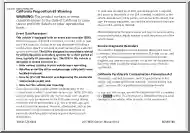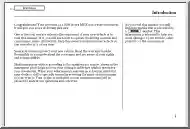No comments yet. You can be the first!
Content extract
Endodontic-access adhesive bridges Chandler NP, Stockdale CR. Endodontic-access adhesive bridges. Endod Dent Traumatol 1987; 3: 209-12 Abstract - Acid-etch retained appliances have a role in the management of dental trauma, both as splints and for the replacement of missing teeth. Two clinical cases are described In the first, a tooth with a fractured root is used as an abutment for a bridge that replaces an avulsed tooth. The metalwork is modified with a "window" to facilitate endodontic therapy should this become necessary in the future. In the second case, an etched splint with a "window" supports a tooth of poor prognosis while an endodontic implant is placed and healing occurs. Further designs are considered for applications in similar circumstances. A resin-bonded perforated cast metal appliance for splinting periodontally involved teeth was described by Rochette in 1973 (1). The attachment ofthe flanges to etched tooth enamel was by mechanical interlock of
resin extruded into the perforations. With pontics added, the "Rochette" bridge became a widely used restoration for the replacement of missing teeth (2). Initially it was thought that by increasing the number of perforations, and by countersinking them, the retention of the appliance would be increased. More recent work suggests (3) that there is no relationship between the size and shape of the holes in the metal framework and its retention to tooth structure. Some later designs of Rochette bridges have window-frame patterns which are easily constructed using preformed wax rods (4). In 1981 a method of electrolytically etching cast nietal surfaces was described, and non-perforated appliances made by this method are termed "Maryland" bridges. The resin bond is over a larger area and is less prone to absorption and leakage. The minimal tooth preparation and splinting and tooth replacement possibilities render them useful in the management of dental trauma. In 1974
Burrell & Goldberg (5) described the vented endodontic-access crown. This full coverage restoration was suggested for extensively restored teeth of poor pulpal prognosis. An "access cavity", as part of the casting, simplified endodontic treatment if this proved necessary at a later date. This report describes two adhesive bridges with splinting or prosthetic function that were designed with vented retentive Oanges to facilitate endodontic procedures. Niciioias Paui Ciiandier and Ciiarles Robert Stociidaie Department of Conservative Dentistry, University Dental Hospital of Manchester, Manchester, England Key words: root canal therapy, denfal impiantation, endosseous, denfal prosthesis design. N. P Chandler BDS, LDS, FDS, (Glas and Edin) FFD, Lecfurer in Resforafive Dentistry, University Denfal Hospifal of Manchesfer, Higher Cambridge Sfreef, Manchester, Ml5 6FH England. Accepfed for publicafion 2 February 1987. Case one A 23-year old female came to the Manchester
Dental Hospital, having lost a tooth earlier that day in a motorcycle accident. On examination, the maxillary right central incisor was absent and the left central incisor was slightly displaced palatally. Both the right lateral incisor and the left central incisor featured mesial incisal edge fractures into dentine. Radiographs revealed an empty socket in the right central incisor site, and a middle third root fracture of the left central incisor. Immediate treatment involved: 1. Relocation ofthe left central incisor under local anaesthesia. 2. Calcium hydroxide (Dycal®, LD Caulk Co, Milford, DE, USA) placed over exposed dentine and protected with polycarboxylate as dressings for the fractured teeth. 3. Impressions for the construction of an acrylic partial denture retained by Adams cribs to replace the lost right central incisor. The left central incisor remained stable during this procedure When examined 1 month later, the left central incisor responded to pulp tests but was tender
if pressure was applied. The tooth was splinted using orthodontic wire and acid-etch composite. Ten weeks later a radiograph showed no abnormal pathology and the splint was removed (Fig. 1) The tooth was firm, pain-free and continued to respond to pulp tests. The right central incisor socket had healed and the partial denture had become unretentive. It was decided that it should be replaced as soon as possible with a fixed prosthesis 209 Chandler and Stochdale r Fig. 2 Bridge with pontic replacing maxillary right central incisor with windowed flange on maxillary left central incisor (mirror view) Case twe Fig. I Radiograph of maxillaiy lclt central incisor with root fracture following 10 weeks splinting. Nevertheless, a conventional fixed bridge was contraindicated because of the status of the potential abutments. Although root fractures in themselves have recently been shown to have little influence on continued pulp sensitivity (6), Andreasen & Hjorting-Hansen noted signs
of pulpal necrosis in almost half of a series of 50 traumatized teeth that featured fractured roots (7). It was therefore considered prudent to provide a prosthesis to facilitate access to the upper left central incisor should pulpal necrosis occur. A Maryland bridge was considered, with a perforated retentive flange on the left central incisor to allow a future access cavity to be cut directly into tooth substance, as cutting through a metal framework cati damage the bond by vibration or thermal damage to the resin. The damaged incisal edges were restored with composite and impressions for the bridge were taken. The entire fitting surface of the bridge, including the periphery of the perforated fiange, was elcctrolytically etched. Mirror and labial views show the bridge, which has proved comfortable, functional and aesthetically pleasing (Figs. 2 and 3) One year after the accident the left central incisor continues to respond normally and is under regular clinical and radiographic
review. 210 A 42-year-old male patient was referred to ihc Manchester Dental Hospital regarding the management of the maxillary right central incisor, which had suffered a root fracture 30 years previously in a school playground accident. The tooth had received immediate post-trauma treatment al ihis Hospital, which had involved a period of splinting. Il had remained symplom-fi-ee but slightly mobile until the time of referral. On this most recent occasion, the upper anterior leeth were of normal colour and sensitive to electric pulp tests. The gingival condition was good, but multiple sinuses were noted 4 mm apical to the gingival margin of lhe right central incisor labially, and a palatal sinus was also present. Periapical radiographs revealed a horizontal root fracture in lhe middle ihird of the right central incisor, with marked bone loss adjacent lo the fracture fine (Fig. 4). Fig. 3 Labial view of bridge Endodontic-access adiiesive bridges Fig. 5 Splint wilh window design
lo support maxillary righl central iticisor. During this procedure some difficulty was encountered with the reamers binding on the incisal bar ofthe splint window. It was not practicable to adjust the metalwork at this stage. In due course a matched Vitallium implant was cemented in place with Tubliseal® (Kerr, Romulus, MI, USA), with the terminal end ofthe implant engaging in alveolar bone. Fig. 4 Radiograph of maxillary riglil central incisor wilh iraclure in tlie middle third of the root. Bone loss is evident adjacent lo the fracture line. Removal of the non-vital apical fragment and placement of an endodontic implant was suggested in the hope of conserving the tooth for this highly motivated patient. This surgical endodontic approach was decided upon as it would: 1) allow removal of the non-vital apical fragment; 2) splint the mobile coronal portion ofthe tooth; and 3) give access to any pathological material present adjacent to the fracture site. A splint would be required to
support the mobile coronal portion, both during the surgical procedure and postoperatively while bone regeneration occurred. There was sufficient palatal occlusal clearance for Maryland metalwork, which would avoid the aesthetic disadvantages of a composite and wire splint. A windowed design was made with supporting fianges on the right lateral incisor and the left central incisor and cemented with a composite adhesive bridge cement (ABC Cement, Vivadent, Liechtenstein) (Fig. 5) Under local anaesthesia, a full nuicoperiosteal flap was raised and the fractured apical root fragrnent removed. The root face was smoothed with burs and the canal subsquently reamed, the reamer passing beyond the fbrameii on the root face. Fig. 6 Radiograph of incisor with endodontic implant Bony liealing is taking place. 211 Chandler and Stockdale Following the closure of the wound, a partial debonding ofthe splint was repaired with a 2-paste composite. A radiograph taken 5 weeks postoperatively
suggested that bony healing was taking place (Fig. 6) There are many conflicting reports concerning the ideal materials and success rates of endodontic implants (8). Five-year success rates over 90% have been reported, although most writers consider the procedure to be experimental and one of "buying time" (8-10). In the case reported it is hoped that in due course the splint may be removed and the tooth can remain as a healthy functioning unit. such modifications are in progress, and their longterm value in the treatment of traumatized patients is being evaluated. Acknowledgements We would like to thank D;. J D. Lilley for his advic: on the preparation of the manuscript, and the Department of Medical Illustration, Manchester Royal Infirmary for the photographs. References 1. RociiETTE AL Attachment of a splint lo enamel of lower anterior leeth. J Prosthet Dent 1973; 30: 418-23 2. TAY W M , SHAW M J The Rochette adhesive bridge Dent Update 1979; 6: 153-7. 3. WILLIAMS VD,
DRENNON D G , SILVERSTONE L M The elfecl Conclusions The advantages of etched cast restorations as prosthetic and splinting devices for young adults and older patients can be retained while allowing access for endodontic procedures on abutting teeth. Experience with the second case suggested the incisal bar, if omitted, would further improve instrument access, although retention from resin extrusion into the perforation would then be lost. It is not known whether the remaining U-shaped piece of etched cast framework would provide adequate retention. In the case of non-vital teeth, extra retention could be achieved using suitably placed parallel pins as an integral part of the casting. Clinical studies of 212 of retainer design on the retention of filled resin in etched fixed partial dentures. J Prosthet Dent 1982; 48: 417-23 4. TAY WM A classification and assessment of composite retained bridges Restorative Dent 1986; 2: 15-22 5. BuRRELL WE, GOLDBERG AT Vented endodontic-access
crowns. J Prosthei Dent 1974; 32: 267 9 6. BIRCH R, ROCK WP The incidence of complications following root fracture in permanent anterior teeth Br Dent J 1986; mO: 119. 7. ANDKEASEN J O , HJORTING-HANSEN E Iiitra-alveolar root fractures: radiographic and histologic .sludy of 50 cases Oral Surg Oral Med Oral Pathol 1967; 25: 414-26. 8. NICHOLLS E Endodontics 3rd ed Bristol; Wright, 1984; 311 9. CRANIN A N , RABKIN ME, GARFINKEL L A statistical evalu- ation of 952 endosteal implants in humans. J Am Dent Assoc 1977; 94: 315. 10. JOHNS R B Implants and reimplantation General dental practice. Instalment 9 Middlesex: Kluwer Publications Ltd., June 1986
resin extruded into the perforations. With pontics added, the "Rochette" bridge became a widely used restoration for the replacement of missing teeth (2). Initially it was thought that by increasing the number of perforations, and by countersinking them, the retention of the appliance would be increased. More recent work suggests (3) that there is no relationship between the size and shape of the holes in the metal framework and its retention to tooth structure. Some later designs of Rochette bridges have window-frame patterns which are easily constructed using preformed wax rods (4). In 1981 a method of electrolytically etching cast nietal surfaces was described, and non-perforated appliances made by this method are termed "Maryland" bridges. The resin bond is over a larger area and is less prone to absorption and leakage. The minimal tooth preparation and splinting and tooth replacement possibilities render them useful in the management of dental trauma. In 1974
Burrell & Goldberg (5) described the vented endodontic-access crown. This full coverage restoration was suggested for extensively restored teeth of poor pulpal prognosis. An "access cavity", as part of the casting, simplified endodontic treatment if this proved necessary at a later date. This report describes two adhesive bridges with splinting or prosthetic function that were designed with vented retentive Oanges to facilitate endodontic procedures. Niciioias Paui Ciiandier and Ciiarles Robert Stociidaie Department of Conservative Dentistry, University Dental Hospital of Manchester, Manchester, England Key words: root canal therapy, denfal impiantation, endosseous, denfal prosthesis design. N. P Chandler BDS, LDS, FDS, (Glas and Edin) FFD, Lecfurer in Resforafive Dentistry, University Denfal Hospifal of Manchesfer, Higher Cambridge Sfreef, Manchester, Ml5 6FH England. Accepfed for publicafion 2 February 1987. Case one A 23-year old female came to the Manchester
Dental Hospital, having lost a tooth earlier that day in a motorcycle accident. On examination, the maxillary right central incisor was absent and the left central incisor was slightly displaced palatally. Both the right lateral incisor and the left central incisor featured mesial incisal edge fractures into dentine. Radiographs revealed an empty socket in the right central incisor site, and a middle third root fracture of the left central incisor. Immediate treatment involved: 1. Relocation ofthe left central incisor under local anaesthesia. 2. Calcium hydroxide (Dycal®, LD Caulk Co, Milford, DE, USA) placed over exposed dentine and protected with polycarboxylate as dressings for the fractured teeth. 3. Impressions for the construction of an acrylic partial denture retained by Adams cribs to replace the lost right central incisor. The left central incisor remained stable during this procedure When examined 1 month later, the left central incisor responded to pulp tests but was tender
if pressure was applied. The tooth was splinted using orthodontic wire and acid-etch composite. Ten weeks later a radiograph showed no abnormal pathology and the splint was removed (Fig. 1) The tooth was firm, pain-free and continued to respond to pulp tests. The right central incisor socket had healed and the partial denture had become unretentive. It was decided that it should be replaced as soon as possible with a fixed prosthesis 209 Chandler and Stochdale r Fig. 2 Bridge with pontic replacing maxillary right central incisor with windowed flange on maxillary left central incisor (mirror view) Case twe Fig. I Radiograph of maxillaiy lclt central incisor with root fracture following 10 weeks splinting. Nevertheless, a conventional fixed bridge was contraindicated because of the status of the potential abutments. Although root fractures in themselves have recently been shown to have little influence on continued pulp sensitivity (6), Andreasen & Hjorting-Hansen noted signs
of pulpal necrosis in almost half of a series of 50 traumatized teeth that featured fractured roots (7). It was therefore considered prudent to provide a prosthesis to facilitate access to the upper left central incisor should pulpal necrosis occur. A Maryland bridge was considered, with a perforated retentive flange on the left central incisor to allow a future access cavity to be cut directly into tooth substance, as cutting through a metal framework cati damage the bond by vibration or thermal damage to the resin. The damaged incisal edges were restored with composite and impressions for the bridge were taken. The entire fitting surface of the bridge, including the periphery of the perforated fiange, was elcctrolytically etched. Mirror and labial views show the bridge, which has proved comfortable, functional and aesthetically pleasing (Figs. 2 and 3) One year after the accident the left central incisor continues to respond normally and is under regular clinical and radiographic
review. 210 A 42-year-old male patient was referred to ihc Manchester Dental Hospital regarding the management of the maxillary right central incisor, which had suffered a root fracture 30 years previously in a school playground accident. The tooth had received immediate post-trauma treatment al ihis Hospital, which had involved a period of splinting. Il had remained symplom-fi-ee but slightly mobile until the time of referral. On this most recent occasion, the upper anterior leeth were of normal colour and sensitive to electric pulp tests. The gingival condition was good, but multiple sinuses were noted 4 mm apical to the gingival margin of lhe right central incisor labially, and a palatal sinus was also present. Periapical radiographs revealed a horizontal root fracture in lhe middle ihird of the right central incisor, with marked bone loss adjacent lo the fracture fine (Fig. 4). Fig. 3 Labial view of bridge Endodontic-access adiiesive bridges Fig. 5 Splint wilh window design
lo support maxillary righl central iticisor. During this procedure some difficulty was encountered with the reamers binding on the incisal bar ofthe splint window. It was not practicable to adjust the metalwork at this stage. In due course a matched Vitallium implant was cemented in place with Tubliseal® (Kerr, Romulus, MI, USA), with the terminal end ofthe implant engaging in alveolar bone. Fig. 4 Radiograph of maxillary riglil central incisor wilh iraclure in tlie middle third of the root. Bone loss is evident adjacent lo the fracture line. Removal of the non-vital apical fragment and placement of an endodontic implant was suggested in the hope of conserving the tooth for this highly motivated patient. This surgical endodontic approach was decided upon as it would: 1) allow removal of the non-vital apical fragment; 2) splint the mobile coronal portion ofthe tooth; and 3) give access to any pathological material present adjacent to the fracture site. A splint would be required to
support the mobile coronal portion, both during the surgical procedure and postoperatively while bone regeneration occurred. There was sufficient palatal occlusal clearance for Maryland metalwork, which would avoid the aesthetic disadvantages of a composite and wire splint. A windowed design was made with supporting fianges on the right lateral incisor and the left central incisor and cemented with a composite adhesive bridge cement (ABC Cement, Vivadent, Liechtenstein) (Fig. 5) Under local anaesthesia, a full nuicoperiosteal flap was raised and the fractured apical root fragrnent removed. The root face was smoothed with burs and the canal subsquently reamed, the reamer passing beyond the fbrameii on the root face. Fig. 6 Radiograph of incisor with endodontic implant Bony liealing is taking place. 211 Chandler and Stockdale Following the closure of the wound, a partial debonding ofthe splint was repaired with a 2-paste composite. A radiograph taken 5 weeks postoperatively
suggested that bony healing was taking place (Fig. 6) There are many conflicting reports concerning the ideal materials and success rates of endodontic implants (8). Five-year success rates over 90% have been reported, although most writers consider the procedure to be experimental and one of "buying time" (8-10). In the case reported it is hoped that in due course the splint may be removed and the tooth can remain as a healthy functioning unit. such modifications are in progress, and their longterm value in the treatment of traumatized patients is being evaluated. Acknowledgements We would like to thank D;. J D. Lilley for his advic: on the preparation of the manuscript, and the Department of Medical Illustration, Manchester Royal Infirmary for the photographs. References 1. RociiETTE AL Attachment of a splint lo enamel of lower anterior leeth. J Prosthet Dent 1973; 30: 418-23 2. TAY W M , SHAW M J The Rochette adhesive bridge Dent Update 1979; 6: 153-7. 3. WILLIAMS VD,
DRENNON D G , SILVERSTONE L M The elfecl Conclusions The advantages of etched cast restorations as prosthetic and splinting devices for young adults and older patients can be retained while allowing access for endodontic procedures on abutting teeth. Experience with the second case suggested the incisal bar, if omitted, would further improve instrument access, although retention from resin extrusion into the perforation would then be lost. It is not known whether the remaining U-shaped piece of etched cast framework would provide adequate retention. In the case of non-vital teeth, extra retention could be achieved using suitably placed parallel pins as an integral part of the casting. Clinical studies of 212 of retainer design on the retention of filled resin in etched fixed partial dentures. J Prosthet Dent 1982; 48: 417-23 4. TAY WM A classification and assessment of composite retained bridges Restorative Dent 1986; 2: 15-22 5. BuRRELL WE, GOLDBERG AT Vented endodontic-access
crowns. J Prosthei Dent 1974; 32: 267 9 6. BIRCH R, ROCK WP The incidence of complications following root fracture in permanent anterior teeth Br Dent J 1986; mO: 119. 7. ANDKEASEN J O , HJORTING-HANSEN E Iiitra-alveolar root fractures: radiographic and histologic .sludy of 50 cases Oral Surg Oral Med Oral Pathol 1967; 25: 414-26. 8. NICHOLLS E Endodontics 3rd ed Bristol; Wright, 1984; 311 9. CRANIN A N , RABKIN ME, GARFINKEL L A statistical evalu- ation of 952 endosteal implants in humans. J Am Dent Assoc 1977; 94: 315. 10. JOHNS R B Implants and reimplantation General dental practice. Instalment 9 Middlesex: Kluwer Publications Ltd., June 1986




